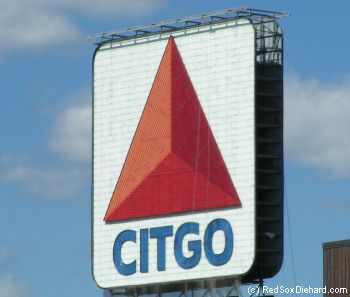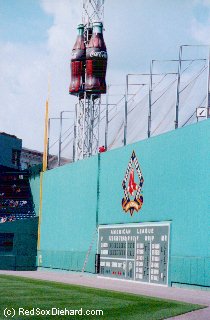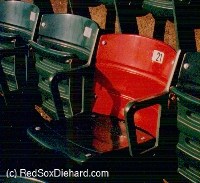|
What makes Fenway Fenway?

Fenway Park is a shrine. People go there to worship.- Bill "Spaceman" Lee
Sure, you can watch baseball anywhere - in a Little League park, on TV in your living room, even in a retractable-roof dome. But what makes the Fenway experience so unique?
(I know it's not the restrooms...)
|
The Dimensions
| Left field foul line: | 310 ft. | | Green Monster: | 37 ft. high, 231 feet long |
| Left-center field: | 379 ft. | | | |
| Center field: | 390 ft. | | Center field wall: | 17 ft. high |
| Deep center field: | 420 ft. | | | |
| Deep right field: | 380 ft. | | Bullpen: | 5 ft. high |
| Right field foul pole: | 302 ft. | | Right field wall: | 3 - 5 ft. high |
| Backstop: | 60 ft. | | | |
Seeing a hitter drive a pitch half-way up the "Green Monster" just to be held to a long single; watching a runner head for third while his ball bounces around in "the triangle"; seeing a player wrap a pitch around "Pesky's Pole" for a 305-foot home run... These are all experiences that can only be had at Fenway.
| |
The Citgo Sign
 Whether you're emerging from the T at Kenmore Square or driving in your car on Storrow Drive, that first view of the Citgo sign signals your proximity to Fenway. During the game, its blinking lights are as much a fixture as the Fenway Frank. When I lived outside New England, driving by a Citgo station always brought a smile to my face and reminded me of home.
Whether you're emerging from the T at Kenmore Square or driving in your car on Storrow Drive, that first view of the Citgo sign signals your proximity to Fenway. During the game, its blinking lights are as much a fixture as the Fenway Frank. When I lived outside New England, driving by a Citgo station always brought a smile to my face and reminded me of home.
It all began in 1940, when Cities Service erected a sign over their divisional offices building. The Citgo sign as we know it today was installed in 1965. The 60-foot-by-60-foot sign is made up of 5,878 glass tubes totaling more than five miles' worth of neon. 250 high-voltage transformers light the sign from dusk till midnight every night. When the sign's lights were turned off in 1979 to save energy, Sox fans rallied, asking that the sign be declared a Boston landmark. While it never achieved official landmark status (because the city of Boston would be financially responsible for maintaining it rather than the Citgo company), the public outcry was so great when Citgo tried to remove the sign a few years later, that the company agreed to leave it in place and turn the lights back on.
For all the facts and statistics, as well as info on the Keeper of the Sign, please visit Citgo's page on the Boston Sign.
| |
The Hand-Operated Scoreboard
The Green Monster and its scoreboard are two of the most famous pieces of Fenway. When the scoreboard was added in 1934, it represented high technology, using colored lights to signal balls and strikes. But today, in the age of Jumbo-Tron scoreboards, the attraction at Fenway is that the line score is still posted by hand, inning by inning, as well as scores for the day's other American and National League games. The numerals are printed on steel, and the ones for runs and hits measure 16 x 16 inches, and weigh three pounds. The initials T.A.Y. and J.R.Y. are written in Morse code on the scoreboard, in memory of Tom A. and Jean R. Yawkey, former Red Sox owners.

In 1975, a camera was installed inside the wall for the first time. Later that year, in Game 6 of the World Series, this camera caught Carlton Fisk waving his extra-inning, game-winning home run fair. The only reason that image lives on (or so the legend goes): the cameraman was distracted by a large rat inside the wall, and briefly stopped following the flight of the ball... while the camera settled on Fisk.
| |
The Ladder

|
In 1936, two years after the left field Wall was constructed in its present dimensions, a 23-foot-high screen was added over the top to protect the windows of buildings across the street. The only way to retrieve balls that were hit into the screen was to climb a ladder that extended up the face of the Wall. Every day after batting practice, a worker would place a removable ladder at the base of the Wall, then ascend the Green Monster ladder to fetch any balls that had landed there. When seats were added atop the Green Monster for the 2003 season, the screen was removed and the ladder was no longer needed, but it remains in place today.
The ladder is in fair territory, and can cause some interesting bounces, as Dick Stuart once found out. The notoriously slow-footed first baseman hit a ball off the ladder in 1963, and it bounced far enough away from the fielders that he was able to leg out an inside-the-park home run.
|
| |
The Red Seat
 On June 9, 1946, Ted Williams hit a mammoth blast to right field, 502 feet from home plate. It traveled to Section 42, Row 37, Seat 21, where it landed on Joseph A. Boucher's straw hat. As Boucher later recalled, "They say it bounced a dozen rows higher, but after it hit my head, I was no longer interested." That Williams shot was the longest ever hit at Fenway. At the time the bleachers were benches and not individual seats, but the seat in that spot has been painted red to mark the location of the famous homer.
On June 9, 1946, Ted Williams hit a mammoth blast to right field, 502 feet from home plate. It traveled to Section 42, Row 37, Seat 21, where it landed on Joseph A. Boucher's straw hat. As Boucher later recalled, "They say it bounced a dozen rows higher, but after it hit my head, I was no longer interested." That Williams shot was the longest ever hit at Fenway. At the time the bleachers were benches and not individual seats, but the seat in that spot has been painted red to mark the location of the famous homer.
I've seen the pictures and heard the stories, but knowing that the red seat is there provides a connection to the past. That's what makes this park so special. It's proof, to anyone who ever sat through a rain delay only to see a rookie pitcher get clobbered, or watched a pinch-hitting backup catcher whiff feebly with the bases loaded, that The Greatest Hitter Who Ever Lived played here, in my Fenway.
|
|

